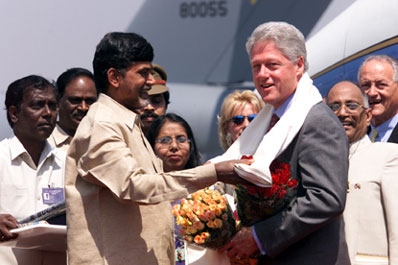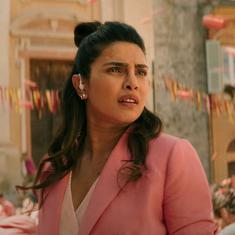Here are some of the highlights of of the blow-hot, blow-cold relationship.
1. Vivekananda in the US

Vivekananda at the Parliament of World Religions. Photo credit: Wikimedia Commons.
There was much back and forth between the countries towards the end of the 19th century. The philosopher Vivekananda, for instance, proved himself the darling of the country when he lectured on Hinduism at the first Parliament of the World’s Religions in Chicago in 1893. Indian school children are still taught the opening line of his first address to the forum.
2. Freedom struggle

Photo credit: Admiralty Official Collection.
Several Indian revolutionaries, especially members of the Ghadr Party, found refuge on the US West Coast during the Independence movement. The traffic wasn't only one way. In 1904, Samuel Evans Stokes, who would later rename himself Satyanand, came to India as a volunteer at a home for lepers in Shimla. By 1921, he had joined the Congress, become a freedom fighter and had also been arrested and jailed for sedition. He eventually converted to Hinduism and died in Shimla in 1946.
India had other supporters for its freedom struggle as well, including Franklin Delano Roosevelt, the president of the US during World War II, who consistently advocated the dismantling of the British empire, to replace colonial capitalism with an industrial kind.
3. Nehru’s first visit to the US

Photo credit: Harry S. Truman Library.
When Nehru became independent India’s first prime minister, he made it clear that he would not ally with either power in the rapidly developing Cold War between the Soviet Union and the US. He made his first visit to the US in 1949, where he met President Truman, but the visit was not an unequivocal success.
4. The Green Revolution

Photo credit: USAID.
The tension continued, even as Nehru asked the US for aid in food during the 1940s and '50s. But this dependence on foreign did prompt the Indian government to invite Norman E Borlaug, an American biologist, to experiment with growing high yielding varieties of wheat in Punjab in 1961.
5. Liberating Bangladesh

USS Enterprise. Photo credit: Naval Historical Centre.
A decade later, American relations were at a new low. Indira Gandhi decided to aid Bangladesh in its freedom struggle. The Americans did not like other people’s freedom struggles unless Washington was involved, and they made it clear to Gandhi that her interference was not acceptable.
In a private conversation declassified in 2005, then president Richard Nixon and Henry Kissinger repeatedly referred to Indira Gandhi as a scheming “bitch” who had clearly manipulated them. This culminated in the US sending its battle ship USS Enterprise to the Bay of Bengal in December 1971.
6. Bhopal gas tragedy

Photo credit: ObI.
A pesticide plant owned by the US chemical giant Union Carbide began to leak the poisonous methyl isocyanate gas on the night of the December 2, 1984. The gas spread across Bhopal, killing thousands and maiming several times more for life.
While India pressed the US to extradite Union Carbide CEO Warren Anderson for trial in India, the US never did so, leading to a souring of relations.
7. Economic liberalisation

Photo credit: Sean Ellis.
Facing mind-boggling debt and under pressure from the International Monetary Fund headquartered in Washington, India liberalised its economy in 1991. This opened the way to investments from foreign countries and resulted in Starbucks being opened in major cities across India.
8. Pokhran testing

Photo credit: Government of India.
In 1998, India conducted a second nuclear test at Pokhran. After its first "peaceful" explosion in 1974, all it got was a rap on the knuckles from countries including Canada, France and the US, this time, the world was considerably more outraged, particularly since India had now developed nuclear weapons.
Shortly after the Pokhran test, Pakistan followed it with one of their own. The United Nations imposed sanctions on both the countries and the United States withdrew all foreign aid to the country, including humanitarian.
9. Clinton speaks in Delhi

Chandrababu Naidu meets Clinton. Photo credit: David Scull.
The US’s outrage did not last very long. In 2000, Bill Clinton came to visit India. Although his visit was brief and the American stand on India’s nuclear weapons remained unchanged, he charmed the nation by addressing a joint session of Parliament.
He received a standing ovation, of course. Rajya Sabha member Ambika Soni even recounted how her colleagues leaped over chairs to greet him at the end of his speech.
10. Manmohan claims India loves Bush

Photo credit: White House photo by Eric Draper.
In the US to convince Washington to give India nuclear resources, Manmohan Singh told what might possibly be the biggest lie during his decade of prime ministership. After meeting George W Bush at the White House, he is alleged to have said, “The people of India deeply love you.”
Bush might have been a singularly incompetent president, but this might have been somewhat true given that he had lifted sanctions from India in 2001. This bit of flattery clearly had an effect on the approval of the nuclear deal between the two countries.
11. Devyani Khobragade

Photo credit: Facebook
In the 21st century, Devyani Khobragade, the diplomat who was arrested in New York for allegedly ill-treating her domestic staff, stirred another round of coldness between the two countries that eventually led to US diplomats being prevented from importing cheap liquor for their embassy for a few months.










